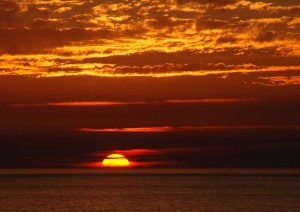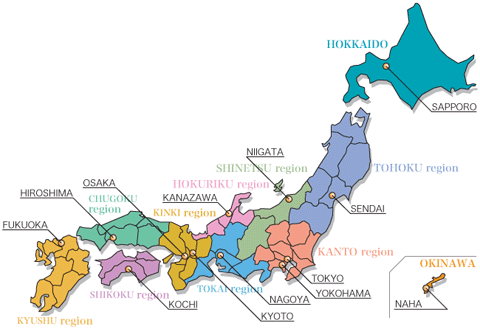blogging earthquake expectations life in Japan living in Japan personal refugee
by sendaiben
leave a comment
Shock Therapy: how a geological event helped cement my minimalist leanings
This post was originally written for an ebook project that never happened. I’m happy to publish it here now.
Are you a wannabe minimalist? I was. It took a major natural disaster to change that.
I became interested in a minimalist lifestyle a couple of years ago. It started with Leo Babauta and Zen Habits, and progressed to Karol, Tynan, Baker, and others. It was appealing, and I spent hours reading articles, following blogs, looking at lists of possessions and checking out minimalist workspaces.
I didn’t actually do anything to change my life, but it was fun thinking about it.
I guess I had the desire but not the drive, the talk but not the walk. I suspect this may be very common, with a small core of people actually living a minimalist lifestyle, and a wider circle of spectators seeing the benefit but not taking action.
This all changed in March 2011. I was just getting ready to teach on an ordinary Friday afternoon when the fourth largest earthquake in recorded history hit the city I live in, doing substantial damage in itself and causing a devastating tsunami. Luckily my seven year-old students hadn’t arrived at the classroom yet, so I didn’t have to worry about them being hurt when everything in the room flew five feet sideways, including computers, tables, and bookshelves.
The earthquake lasted for about five minutes, which is about four and a half minutes too long for comfort. We’re used to earthquakes here, but they normally only last a few seconds. This one started, then got stronger and stronger, and everything just kept violently shaking for what seemed like forever.
After it finally stopped, I left the classroom and checked on some of our neighbors, then stood in a nearby park with other members of the community, all of us shocked into silence.
That evening I sat with my family in our large rental house by candlelight, surrounded by electrical appliances that no longer worked, huddling together for warmth under all our blankets and quilts.
The next day we foraged for food. Going through my daughter’s apartment, taking only food and water and leaving CDs, magazines, clothes, TVs, and furniture behind really made an impression on me. Likewise when we found all the shops closed and shuttered. Gas stations, chained up. Didn’t matter how good your credit was, how much money you had in your wallet.
We’re all just a couple of hours away from that.
That night, back at home taking stock, we received a couple of phone calls from friends and family abroad (I have no idea how they got through as the phone network was down) warning us about the unfolding nuclear accident in Fukushima. We live just under 100km away.
I made a quick decision based on a decision matrix taking into account what would happen under each of four scenarios: there were two variables, whether the accident was serious or not, and whether we left or not. The outcomes were, in turn:
1. the accident was not serious, and we stayed put: nothing happens
2. the accident was not serious, and we ran away: somewhat embarrassing and would cost some money
3. the accident was serious, and we stayed put: irradiation and mass panic when people realised what was happening
4. the accident was serious, and we ran away: safety and some monetary expense
There wasn’t much contest. I persuaded my family, we packed our cars, and we set off a couple of hours later, driving through the night and most of the next day until we got to relative safety in western Japan, several hundred kilometers and a mountain range away from the danger zone.
I locked our house and walked away from everything I owned that didn’t fit into a small bag. We got into the car and left forever as far as we knew.
And you know what? I didn’t care about any of it. For the four weeks we spent with relatives in Kanazawa, on the western coast of Japan, not once did I think of an actual thing we had left behind. Family? We took everyone with us. Friends? Yes. Students? Yes. Our stuff? Not once.
Not one piece of clothing, not one gadget, not one room of the (too) large house we rented.
And that’s when I became a real minimalist.
Just over two years after the event that changed everything, we are living in a small apartment (our rental house was structurally damaged and had to be knocked down), I haven’t bought anything physical for months (sadly, ebooks and music still draw my eye occasionally -I am not yet a digital minimalist), and I am consciously reducing the things I have left.
The next time we have to leave in the middle of the night, I’m hoping to be able to take everything with me.
In Search of Sanuk (why you might care about an obscure charity in Thailand)
I first saw this video in December last year. Something about it really touched me, so I sent a small donation via the website.
A couple of days later, Dwight emailed me to say thanks. Something about him, and the project, stuck with me though, so I emailed him again to see if he could meet up.
Last week, I managed to make it to Bangkok and we went out to dinner. I wanted to know more about his project, and more importantly I wanted to see if he was for real.
Dwight started off like many of us, teaching English in Bangkok. Unlike many of us though, he noticed a serious social problem and decided to make the world better, one family at a time. Dwight works with refugees in Thailand, people who are in Thailand illegally, unwelcome and ignored, with no source of support. His In Search of Sanuk organization (sanuk means ‘fun’ in Thai) aims to help them financially and more importantly socially. Maybe it’s because I am an immigrant here in Japan, but I feel what he is doing is extremely important.
I am very comfortable here, but I have had tough times, even with all the support and advantages I have enjoyed. I cannot imagine doing the same thing with no support, all the while trying to avoid the authorities’ attention. I think what Dwight it doing is so important that I would like to ask you to check it out, and consider sending him a donation or visiting the project if you are ever in Bangkok. In Search of Sanuk can be found by clicking on the following links: Facebook page, website, and Youtube channel.
earthquake life in Japan living in Japan personal refugee
by sendaiben
5 comments
The Great East Japan Disaster Part Three: Refugee 1.0
The third installment. See Part One and Part Two if you are confused.
The Great East Japan Disaster Part Three: Refugee 1.0
The actual drive from Sendai to Kanazawa was nightmarish, not because it was particularly bad, but rather because it seemed vividly unreal.
We left the house about 2:30am, and headed south on Route 4 as the expressways were all closed due to the earthquake. We had half a tank of fuel, something that will become significant shortly. The power was off everywhere, so we had to slow down at each intersection to check for cars. No lights in houses, no street lights, no traffic lights. It was strangely peaceful and slightly eerie, with no other cars to be seen. The roads in the southern part of Sendai were not damaged, unlike the east of the city where our classroom is, where they buckled and cracked dramatically.
After an hour or so I couldn’t keep my eyes open, so I got my wife to take over driving duties and napped in the passenger seat. We were just north of Fukushima city at that point.
Of course, we had originally planned to go west then down the Sea of Japan coast. Unfortunately the fact that we only had half a tank of petrol made it seem more sensible to use the main roads to the south, even if that did take us closer to the reactor than we were comfortable with. Remember, at this point all we knew is that the plant was at risk, so we were very nervous about worst case scenarios (in hindsight, with some justification!).
After a couple of hours of sleep, I woke up and resumed driving. We passed through town after town, all silent and dark, and it wasn’t until we reached the southern end of Fukushima that the electricity came back on. Even then, shops and more importantly, petrol stations were closed and boarded up.
Further and further south we drove, with the fuel gauge dropping lower and lower. It was just outside Utsunomiya that I started getting seriously worried. The needle hit the bottom of the red section, and I figured we probably had about ten kilometres left before we had to ditch the car.
Suddenly we passed a petrol station with a small line of about five cars. It didn’t register for a few seconds, but then I pulled a very sharp u-turn and five minutes later we were in front of a pump. They were out of ordinary petrol, but still had four-star (premium, high-octane). I gratefully filled the tank, and we were on our way.
As we drove on, I realised how lucky we had been to drive past a petrol station that had just opened. Every other one we say for the next hour or two had a line of twenty to thirty cars waiting, or was closed.
The rest of the day was fairly ordinary. We had lunch at a Sukiya (a chain restaurant), stopped at a couple of convenience stores, drove through the most amazing scenery I have seen in Japan (Nagano and Toyama), and finally got to Kanazawa around 6pm, roughly fifteen hours after we set off.
That night we went to a sento (public bathhouse) and out to dinner. It was wonderful.

